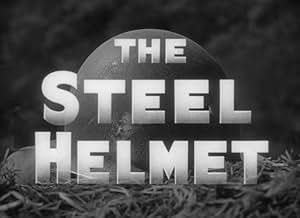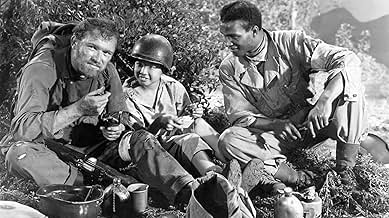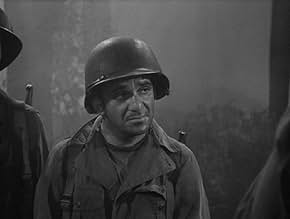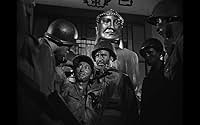Un gruppo di americani combatte contro le truppe comuniste in un tempio buddista abbandonato durante la guerra di Corea.Un gruppo di americani combatte contro le truppe comuniste in un tempio buddista abbandonato durante la guerra di Corea.Un gruppo di americani combatte contro le truppe comuniste in un tempio buddista abbandonato durante la guerra di Corea.
- Regia
- Sceneggiatura
- Star
- Premi
- 1 vittoria in totale
Recensioni in evidenza
*** (out of 4)
Fuller's grim Korean War drama follows Sgt. Zack (Gene Evans) and other rugged men as they take shelter in an abandoned Buddhist temple where they have time to reflect on what they're going in the war. Filmed in a reported ten days, this is one of those rare films that takes place during the war which it is showing. The movie doesn't really take a stance on either side of the line, although there's no question that Fuller wants to get his own ideas across. One of the best scenes involves a black man who is asked how he feels about having to fix these men up yet in the real world he wouldn't be able to sit at the same table with them. There's a lot of racial slurs thrown around at various people but this comes off very realistic as does the rest of the dialogue. You can listen to these men and actually feel like you're in the trenches with them as you'd be hearing this type of conversations. Another big plus is that the movie never paints a pretty picture, which was the type of thing we were use to seeing in war pictures from Hollywood. It's clear Fuller is doing things his way and he didn't care about criticism, which eventually came to the film. Evans delivers a fine and realistic performance as does the rest of the cast. The one negative thing was all the stock footage used at the end but the low budget probably required it. This isn't your typical war film but you can watch it and feel as if you're seeing an original. The influence on movies like FULL METAL JACKET, SAVING PRIVATE RYAN and Tarantino's recent are pretty obvious.
The Steel Helmet tells of a group of infantrymen who have come together by literally running into each other by chance. They travel to a Buddhist temple to set up an observation post, but are soon surrounded by the Communist army. There is then a massive battle that is not exactly pretty for the Americans.
The story is good and moves along at a rate which will keep you intrigued, the battle scenes are very good, and I especially like the part where the medic takes off his helmet, rips off his Red Cross armband and fires the machine gun after the man that was operating it was killed. I wish this movie would come onto video or at least be shown on TV so I can tape it. 8/10
When they reach a Buddhist temple, they learn that it is abandoned and they camp there, transforming it in an observation outpost. When they realize that they are under siege of the communist army, they have to battle to survive.
"The Steel Helmet" is a simple, scathing and extremely realistic film by Samuel Fuller. The behavior of the soldiers and the battle scenes battle scenes are extremely realistic. But the stronger part is the sharp critic to the racism in America, through the dialog of the North Korean POW and the Afro-American soldier first and the Asian descendant soldier later. As an effect of the McCarthyism, Samuel Fuller had problems with the FBI because of these scenes. My vote is eight.
Title (Brazil): "Capacete de Aço" ("Steel Helmet")
Lo sapevi?
- QuizFilmed in ten days only six months after the outbreak of hostilities, this film became the first Korean War movie.
- BlooperShort Round sings the South Korean National Anthem to the tune of "Auld Lang Syne" while Pvt. Bronte plays on his organ. However, the music to South Korea's national anthem was changed from Auld Lang Syne to the Finale of Korea Fantasiaat at a ceremony celebrating the founding of South Korea on August 15th, 1948, exactly three years after liberation from Japanese rule, and three years before The Steel Helmet was made.
- Citazioni
The Red: I just don't understand you. You can't eat with them unless there's a war. Even then, it's difficult. Isn't that so?
Cpl. Thompson: That's right.
The Red: You pay for a ticket, but you even have to sit in the back of a public bus. Isn't that so?
Cpl. Thompson: That's right. A hundred years ago, I couldn't even ride a bus. At least now I can sit in the back. Maybe in fifty years, sit in the middle. Someday even up front. There's some things you just can't rush.
- Curiosità sui creditiInstead of the traditional "The End", the closing title reads, "There is no end to this story".
- ConnessioniFeatured in The Typewriter, the Rifle & the Movie Camera (1996)
- Colonne sonoreAuld Lang Syne
Traditional
I più visti
- How long is The Steel Helmet?Powered by Alexa
Dettagli
Botteghino
- Budget
- 103.000 USD (previsto)
- Tempo di esecuzione
- 1h 25min(85 min)
- Colore
- Proporzioni
- 1.37 : 1




























